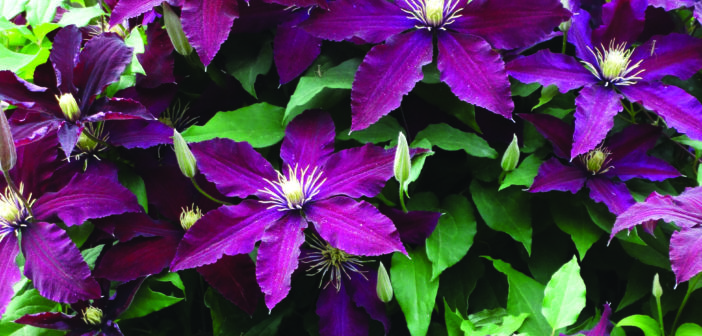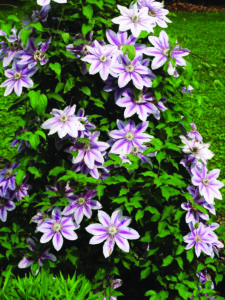Add Color to Your Garden with Clematis
By Steve Zimmerman
Clematis is one of the absolute beauties of the summer garden. This lovely plant derives its name from the Greek word meaning vine, and more than 250 different species and hybrids exist throughout the world. Most of the clematis hybrids we have in our gardens today originated in England, and many of the popular clematis in English gardens are hybrids of Japanese and Chinese native plants.
Clematis was popularly used in English gardens in the late 1800s as a ground cover similar to ivy to create a “wild” garden style. However, in the United States, clematis became popular as a plant to be staked or supported on a trellis.
Over the years, clematis has developed a reputation for being difficult to grow. Like any other plant, if the clematis’ needs are properly met, it will thrive; it is a plant that likes its head in the sun and its feet in the shade.
For best results, clematis should have at least six hours or more of direct sunlight per day. However, its root system requires cool, shaded conditions. This can usually be accomplished by planting your clematis so that the root system is shaded by low-growing shrubbery or perennials. To avoid root competition, make sure that the plants you choose to help shade your clematis roots are not invasive. A layer of mulch will also help to keep the roots cool. The soil needs to be rich and well-drained, and clematis does well with a neutral pH (7.0).
Until established, it is critical to keep your clematis thoroughly hydrated. It is also absolutely imperative for the health of your clematis that you properly prepare its planting site.
Clematis can be a long-lived plant, with some reports of a plant being more than 80 years old and still blooming! To create the ideal conditions for your clematis, dig a hole 12 inches deep by 18 inches wide. The bottom should be covered with compost mixed with bone meal. Your clematis should be planted with the crown four to six inches below the soil line. The newly planted clematis will need a trellis, fence post, or arbor to support the vines.
The clematis is very susceptible to an opportunistic fungus referred to as “clematis wilt.” This fungus attacks after your clematis has sustained a stem injury. This damage is usually caused by poor mowing and trimming practices. The fungus causes damage to the vine, making it wilt and die. If this occurs, remove the damaged area, and the plant will typically generate new growth from the affected area.
How to trim a clematis is a frequently asked question, but you really do not have to trim it. Pruning is usually only necessary if your plant has outgrown its allotted space, and this will not occur if the plant is initially located in a space that will accommodate its mature height. If the flowers it produces are too high on the plant to be enjoyed, you may not wish to prune it, but instead re-tie its supports to lower the plant closer to the ground.
However, if you insist on pruning, there are a few recommended guidelines. Clematis may be divided into three groups in regard to pruning. Group one is the early flowering clematis (April to May); this produces the flowers for next year on this year’s growth so it should be pruned immediately after blooming. The second group is the large flowered hybrid that begins flowering in May and June, and the third group is the large, flowered hybrid that blooms in late June and July.
Both groups two and three produce blooms on this year’s growth and can be pruned to the desired shape and size; just remember to always prune above pairs of buds. For these two groups, it’s best to prune in February or early March. Fertilizing is recommended after pruning; fertilizers for roses will work well on clematis.
Happy gardening!
Steve and Laurie Zimmerman have owned and operated Zimmerman’s Azalea Gardens and Landscaping in Adams County since 1992. Visit their website at www.zaglandscaping.com.





